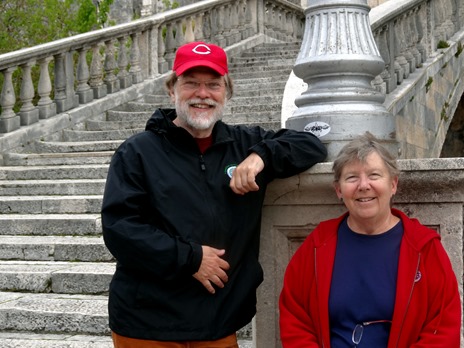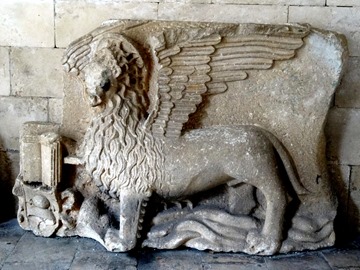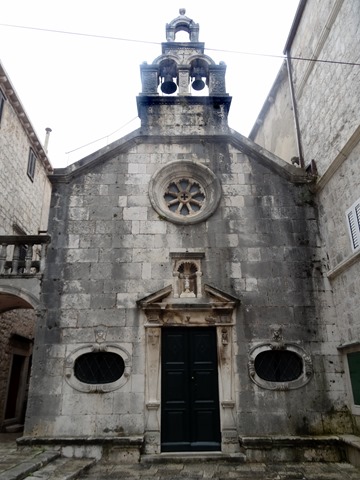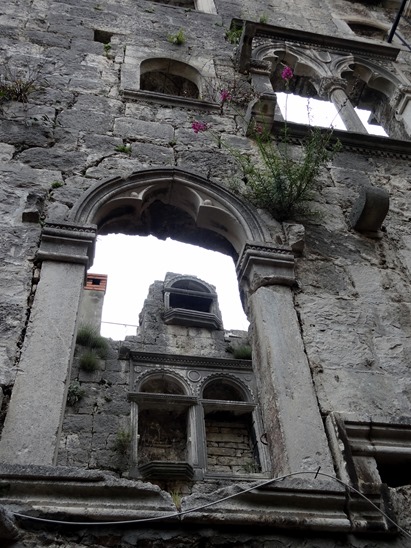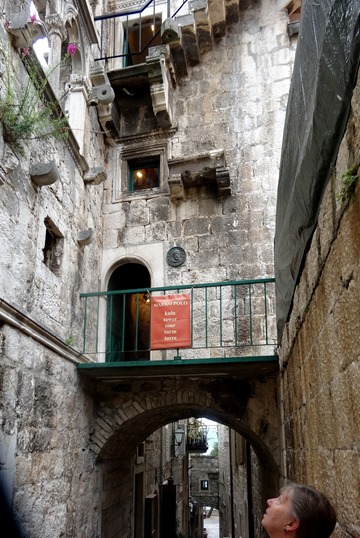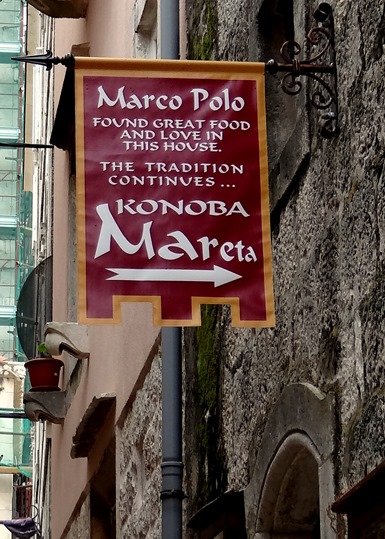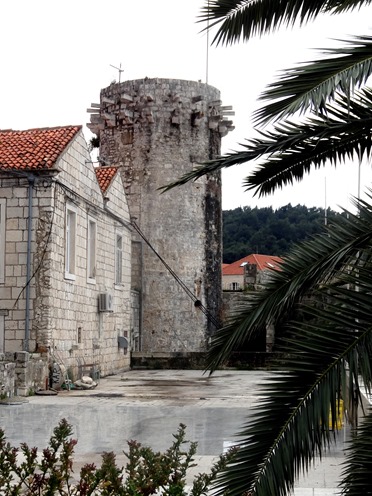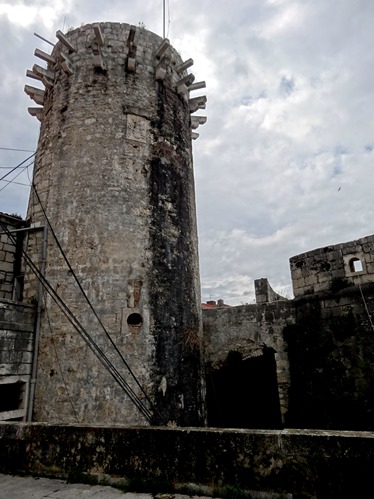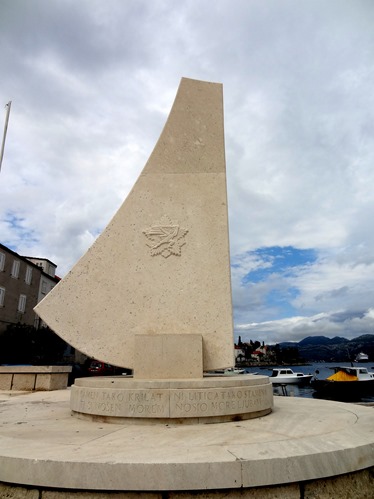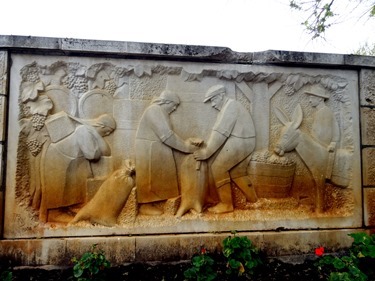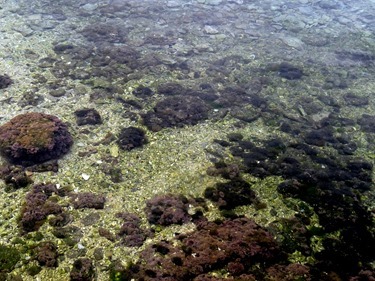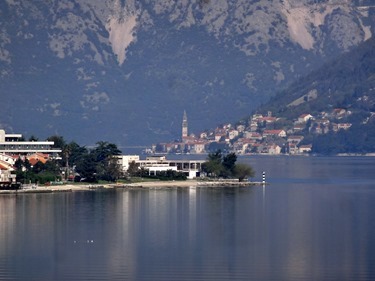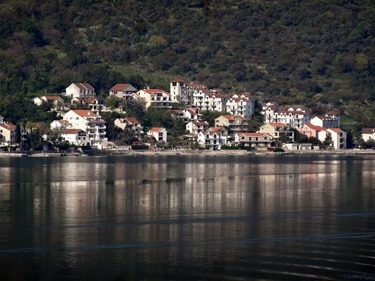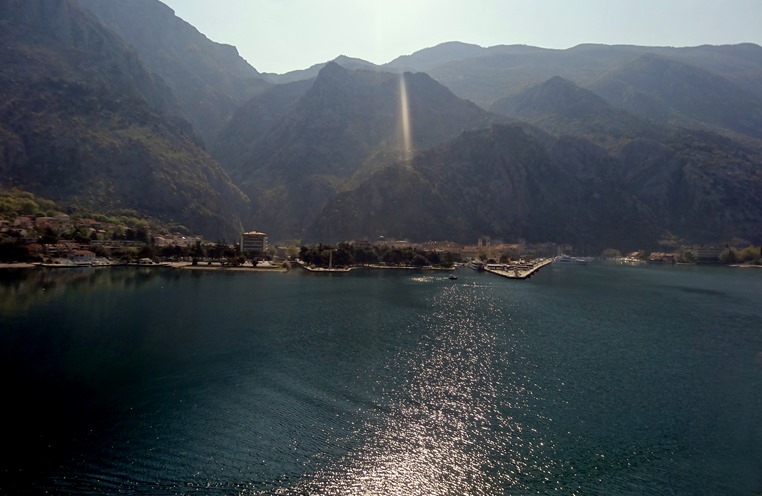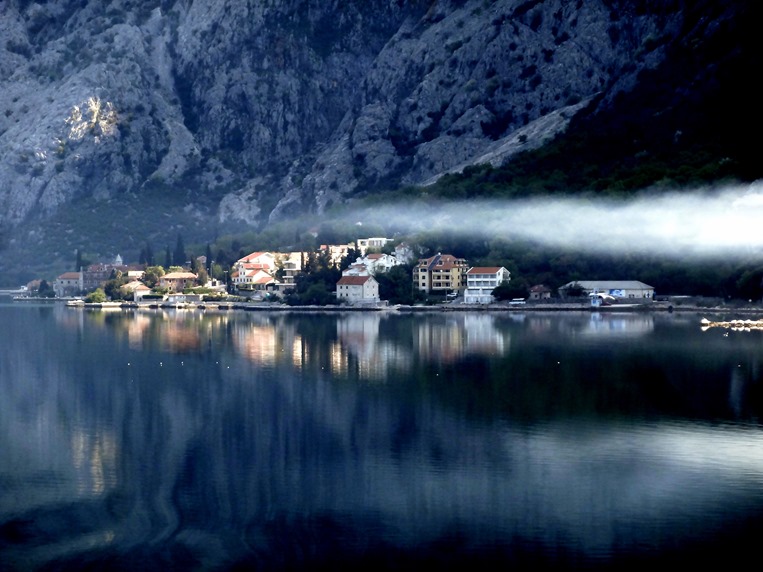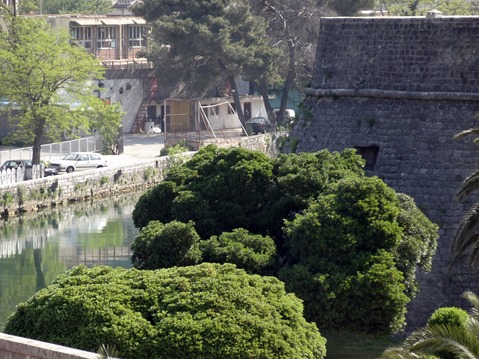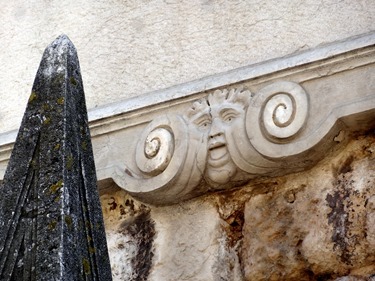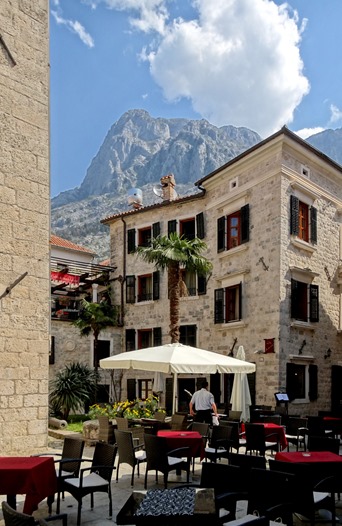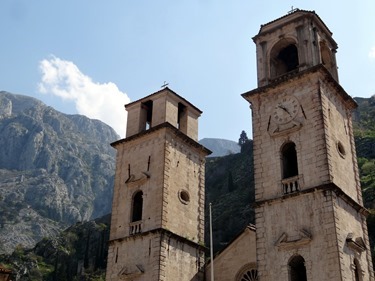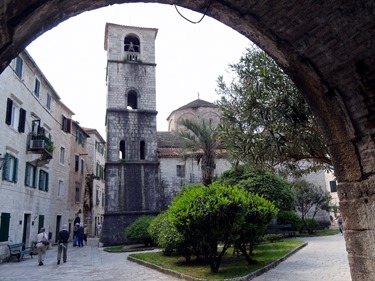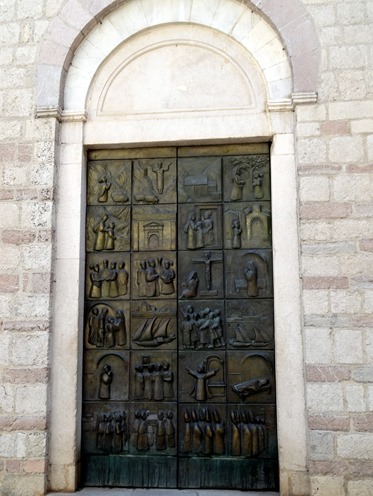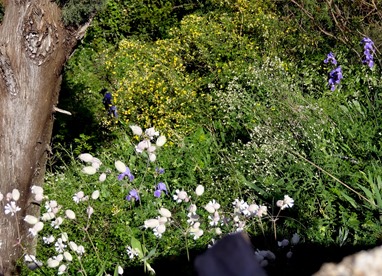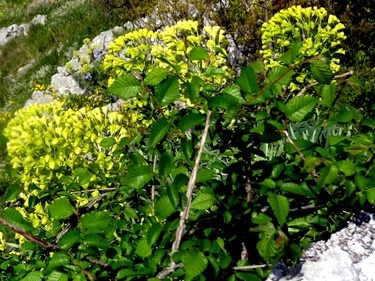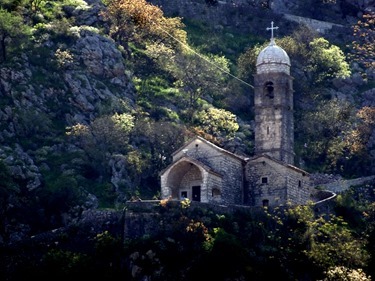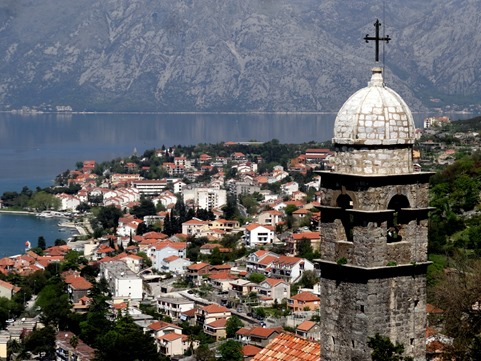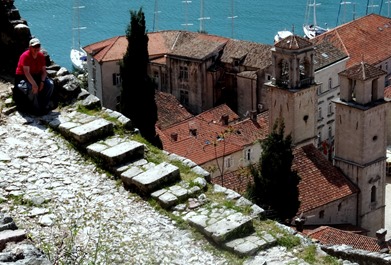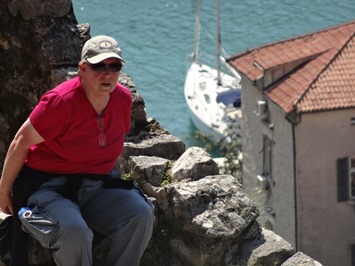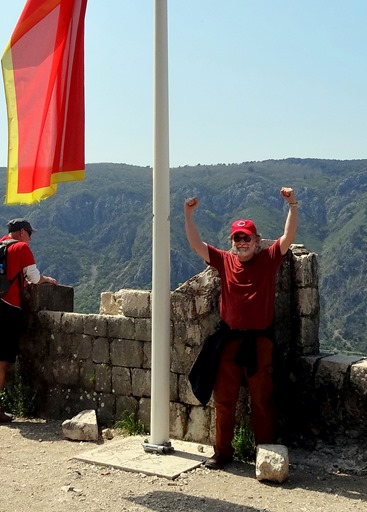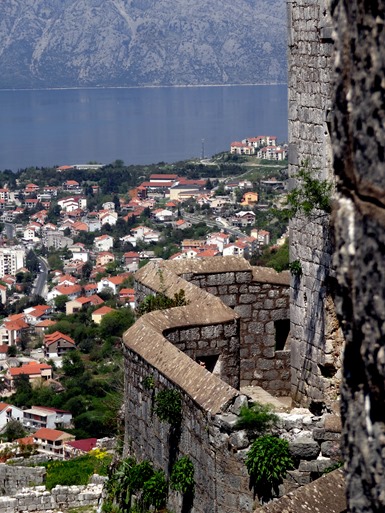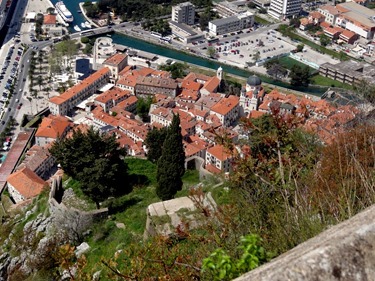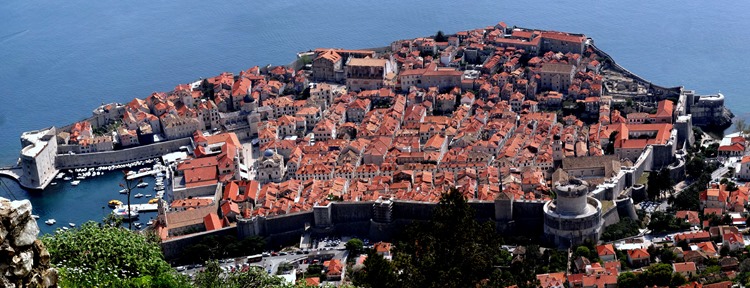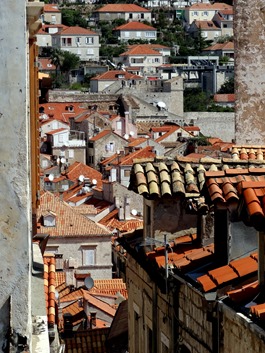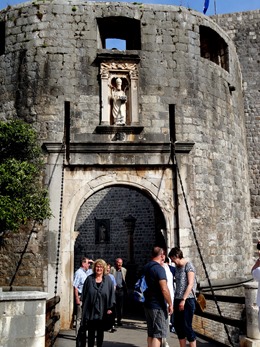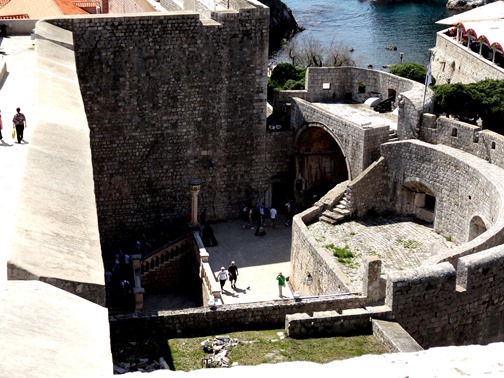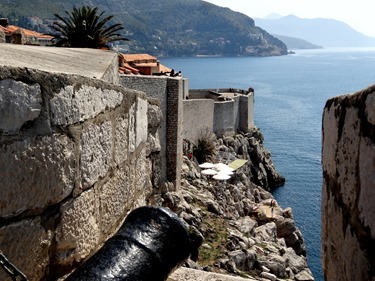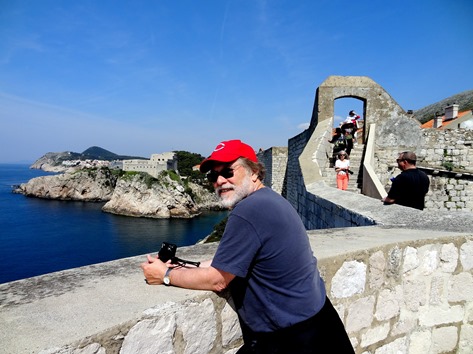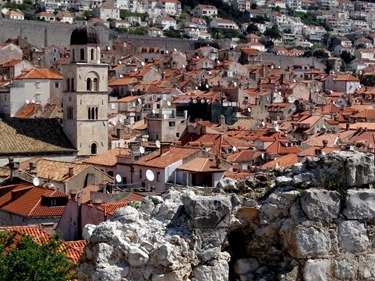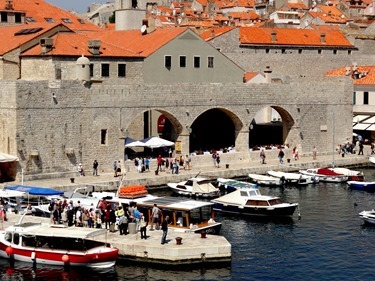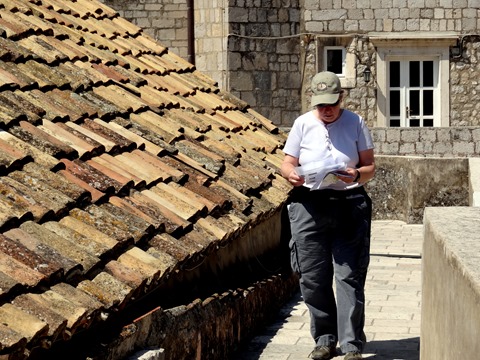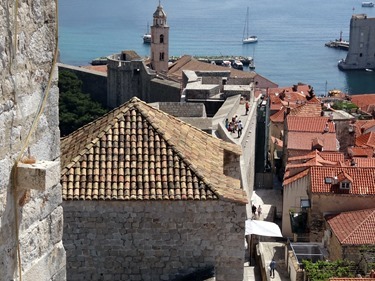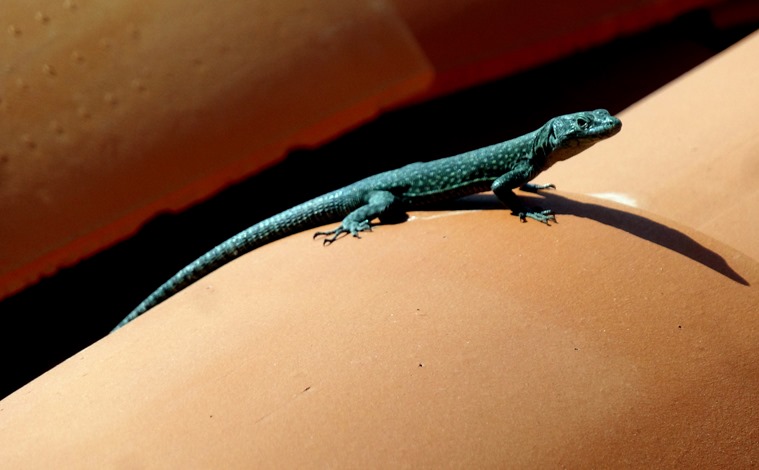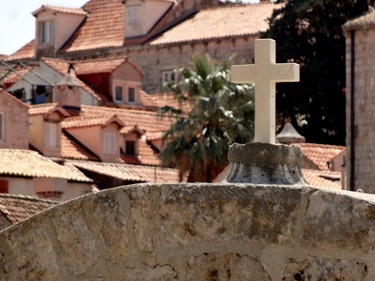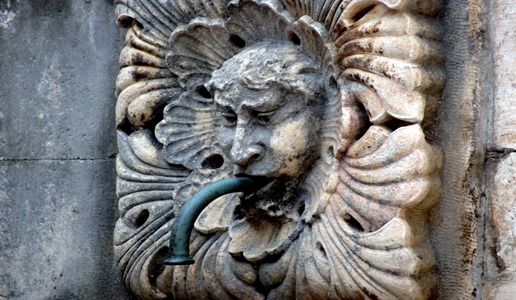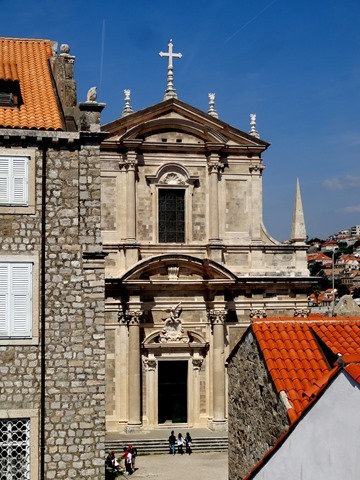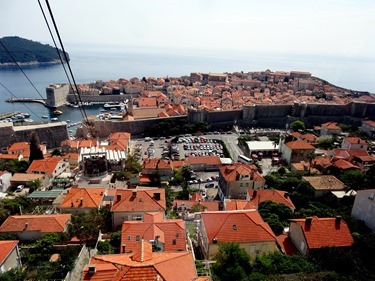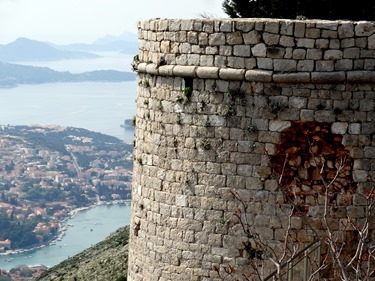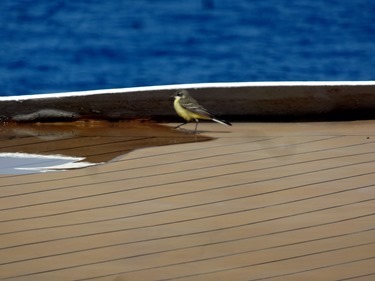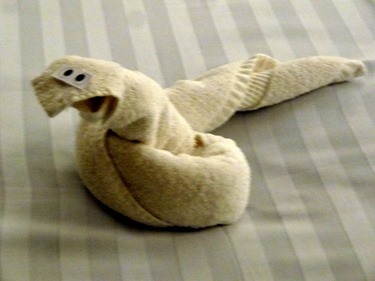Korcula, Croatia
On April 22 we arrived off Korcula, the last of our medieval walled cities on the Dalmatian coast. This was a tender port (ie. the ship is anchored and passengers go to and from the port by tender boat) and it was also a short day, with all aboard scheduled for 1:30. But we found this to be more than enough time for this small town, particularly since almost everything in the old city was closed for the off season (sadly, we were about 9 days too early for the start of the season). Korcula is another walled city on a small isthmus with orange terra cotta roofs & has been called a mini-Dubrovnik. This might have been a little more exciting if we had not been to the actual full sized Dubrovnik only 2 days earlier (and it might have been more interesting if the museums had been open and the Cathedral hadn’t been covered in scaffolding). Still, it was an interesting city to explore & we had a pleasant time (except for the cold weather).
Unlike many medieval cities, Korcula was built according to plan. It is shaped like a horseshoe crab pointing out from the land. The streets are laid out in a sort of herringbone pattern, with a main road running from the main gate toward the rounded point of the crab & rows of fairly straight side streets branching off at a bit of an angle in each direction. It is said that this plan was designed to protect from the harsh south winds but let in the pleasant north winds. Founded by the Greeks in the 4th Century BC, Korcula was later part of the Roman Empire and later was ruled by Venice for a number of centuries. It was part of Yugoslavia after World War I and again after World War II, and is now part of the independent Croatian state.
We entered Korcula by the 15th Century Land Gate, an impressive introduction with a grand stone staircase leading over what once was a moat-like canal to a large crenellated tower. This Revelin Tower has a relief of a Venetian lion of St. Mark flanked by the coats of arms of the Doge of Venice on the left and the rector of Korcula on the right.
The inside of the gate was more elaborate than the outside & the tower was topped with a picture window (it was closed for offseason, so we couldn’t go up to see the view). To the left of the gate after entering is the 16th Century Rector’s palace, which had a nice loggia and a large stone plaque of the lion of St. Mark leaning against a wall. Nearby was an interesting shrine and on the right was the 14th Century Church of St. Michael. Apparently it was believed that a church dedicated to St. Michael inside the town gates would help ward off enemies. The stone overpass to the left of the church leads to the building of the Brotherhood of St. Michael.
We walked on to St. Mark’s Cathedral, the highest point in town. You can see it atop the city looking like a birthday candle on a cake in the first picture. Unfortunately, the cathedral was covered in scaffolding and canvas so we didn’t get to see what it looks like. We went in but no photography was allowed. Across the street is the Gabriellis Palace, which now houses the town museum (closed for offseason, of course).
The last real landmark in Korcula is the so-called Marco Polo’s house. Korcula claims the Marco Polo was born here in 1254, but there is no actual evidence that this is true and it is disputed by historians, who seem to think he was most likely born in Venice. As we have seen elsewhere, however, Korcula has a house claimed to be his birthplace (although it was apparently built a little too late for that) for tourists to pay to visit (but not in offseason). It is an imposing tower of a house with some lovely ruins attached, so it is worth seeing if you are in town whether Marco Polo ever lived there or not. Marco Polo does have a documented relation to Korcula, however. In 1298 he was captured by the Genoese in the Battle of Korcula, a sea battle in which he commanded one of the Venetian ships. While he was a prisoner of war in Genoa Marco Polo and another prisoner collaborated on the book about his travels to China that became something of a sensation (although few believed it at the time) and helped inspire Christopher Columbus to try to sail to China almost two centuries later.
While its streets aren’t maze-like, they are picturesque as in the other Dalmatian cities: narrow and often with arches and stairs.
This is, or at least was, a walled city. The town walls were built at least by the 13th Century, but they were extended and the fortified towers built over the next few centuries by the Venetians (each tower has a plaque of the lion of St. Mark). In the late 19th Century, when the Ottoman threat had long passed and Korcula was no longer a strategic outpost, the Korculans took down the top half of the walls to use for new buildings. But the walls with their massive defensive towers still make a substantial impression.
Outside the walls the city is surrounded by mountains, which were largely covered by clouds the day we were there. There is also a nice strip of waterfront with palm trees (Korcula is actually further north than New York), boats & an interesting monument with reliefs from the era of Socialist Realism.
So that was all for this very short port day, & we returned to the ship. Our friend Jerry (who took the picture of us by the stairway) was returning at the same time and was carrying an expensive SLR camera he had been given by the proprietor of a café where another passenger had left it. An impressive bit of honesty by the proprietor — since no one knew who it belonged to & the ship was getting ready to leave no one would have returned to ask him for it. Jerry did eventually discover the identity of the camera’s owner by pure serendipity (she was standing at the front desk of the ship when Jerry went to turn it in). She was very lucky! Anyway, we sailed away from cloudy & chilly Korcula and the Dalmatian coast to our first stop in Italy, Venice.
Kotor, Montenegro
We pulled into Kotor early in the morning of April 21. We had been told to be sure to arise early for our sunrise sail-in through the beautiful bay of Kotor, but we were tired from Dubrovnik & decided we need our sleep. Luckily for us our entry into the bay was delayed because the port authorities unaccountably gave preference to another cruise ship (our captain was quite irritated). I say luckily for us because this enabled us to see most of the sail-in, which really was stunning. There were rugged mountains surrounding the water, which was uncommonly still and reflective in the morning sun, and picturesque villages lined the shore. Often called the southernmost fjord in Europe, this is not really a fjord but a river canyon that has been submerged by the sea.
In the bay, near the village of Perast, are two islands. The tiny Island of St. George (I am using the English translations, obviously) is surrounded by a dozen Cypress trees and houses a Dominican monastery that has been in operation since the 12th Century. More interesting is the nearby Our Lady of the Rock, which is man made. It seems that on July 22, 1452 some sailors found an icon depicting the Madonna & Child on a rock sticking up out of the water. Thereafter sailors added rocks after every successful voyage and old boats were also filled with rocks and sunk there. Eventually a church was built on the growing island (originally Orthodox, it was later converted to Catholic). To this day, every July 22 the locals fill their boats with rocks & row out to add them to the island.
As we were eating breakfast in the Lido during the sail-in an unusual sight appeared on the port side. A small village spotlighted by the morning sun while the surrounding mountains were still in shadow was covered by its own special cloud. I don’t think I have ever seen anything like it before, particularly with the spooky reflection in the water.
Another interesting phenomenon was the abstract patterns that appeared in the clear still water when the reflections were disturbed by the wake of the ship passing by.
So after all that, we arrived at Kotor & docked just outside the city gate. Kotor is a very small town (about 12,000 people, only about 3,000 live inside the walls) but it has a very long history. The Illyrians had a town here in the 3rd Century BC and by the 1st Century AD it was the Roman town of Catarum (meaning “strangled” probably after the turnings in the bay). An important trading port during the middle ages (its bay was considered the best port between Greece and Venice), when the Ottomans threatened in the 15th Century Kotor asked Venice for help and — by now you should know what’s coming – Venice remained in control for the next 350 years. Napoleon controlled Kotor long enough to build one of the first theaters in the Balkans, and then it was awarded to the Austrian Empire (for which it was the main naval base during World War I) by the Congress of Vienna in 1815. After World War I it became part of Yugoslavia (and its name was changed from Cattaro to Kotor). During World War II it was incorporated into the Italian empire, then after the war it was again part of Yugoslavia. In the Balkan war after the breakup of Yugoslavia Montenegro stuck with Serbia in a rump Yugoslavia, but voted for independence in 2006. Like Dubrovnik, Kotor was devastated by the earthquake of 1667 and it suffered another one in 1979, from which it has only recently finished rebuilding (at least it looks like this is finished).
The old town is laid out in a triangle surrounded by imposing walls, some 3 miles long and up to 50 feet thick & 65 feet high, which extend up the mountain behind the city to St. Ivan’s (St. John’s) Fortress at the top. Along one side just outside the walls runs the Skuda River.
We entered the town through the 16th Century Main Gate (also known as the Sea Gate or Western Gate). There is a pleasant green promenade outside the gate today, but back in the day the water came right up to the gate & security checks were completed (and taxes collected) before a ship could disembark. Above the gate is the seal of Tito’s Yugoslavia and the date when his partisans liberated Kotor from the Nazi puppet regime. There is also a quotation from Tito (translated in the caption of the picture). Nearby is a relief plaque of the Venetian winged lion of St. Mark, which I imagine might have been over the gate during the period of Venetian control.
On the inside of the gate as you pass through is a Gothic relief of the Madonna & Child, with the town’s patron Saint Tryphon holding a model of the town on the left & St. Bernard, a descendant of the local Pima family, on the right. Passing through the gate leads to Arms Square, the town’s largest square. Directly across from the gate is the 17th century clock tower with the triangular pillory in front, where miscreants were chained with placards around their necks stating their crimes so that passing citizens could freely humiliate them. To the left is the Rector’s Palace (the Rector was essentially a Venetian governor) & the Napoleonic Theater, both of which are now part of an upscale hotel.
We wandered through the town a bit on interesting streets of red and white stone blocks highly polished, probably by years of wear. Like many medieval towns Kotor has a maze of narrow streets (which hinder invaders), some with arches above. There are several squares with sidewalk cafes & pumps topping public wells.
The next landmark we came to was the Catholic St. Tryphon’s Cathedral. The story is that in 809 a Venetian ship carrying the relics of St. Tryphon took shelter at Kotor during a storm. Every time they tried to leave the weather worsened, so they concluded that St. Tryphon wanted to stay in Kotor. St. Tryphon became the town’s patron saint & his relics are today in this Cathedral. You will notice that the towers of the Cathedral are not identical, supposedly because they ran out of money before finishing the second tower after the cathedral was damaged by the 1667 earthquake. It was Sunday and religious services were being held, so we didn’t go inside.
St. Luke’s Square contains two Greek Orthodox churches, tiny 12th Century St. Luke’s & the 1909 St. Nicholas which towers over it and whose black domes can be seen prominently over the city. Notice the Greek crosses atop these churches, with two (or even three) horizontal bars. The gold for the crosses atop St. Nicholas was a gift from Russia. You can see the priest in the door of St. Luke’s. When I took the picture he came walking toward us & I thought at first I was going to be admonished for photographing his church (it wouldn’t have been the only time). But he turned out to be unusually friendly. He had noticed me taking the picture & he invited us into his church, showed us around & insisted on taking our picture. All of this with sign language, as he didn’t speak English. At one time during the Venetian period St. Luke’s served both Orthodox & Catholic worshippers with an altar for each. Notice the impressive gold cross over the altar & the icon wall that pretty much filled the tiny adjoining room.
We saw one more church of note (seems like a lot of churches for such a small town). The Church of St. Ozana (also called St. Marija) is in a small green square with called Wood Square next to the town wall. Ozama was a local 16th Century nun who inspired resistance to the Turks. Scenes of her life are depicted on the bronze doors of the church.
Behind the church was a steep & narrow street that leads to the entrance to the top of the town walls. As mentioned, many of Kotor’s streets are narrow, many are topped with arches between buildings and many are also steep enough to need steps. This one was all of those, and it had a double arch above it with a medallion of a Venetian winged lion, the date of its construction (1760) & an impressive looking inscription in Latin that turned out to be just a mundane street sign (translated in the picture caption).
So we paid our 3 Euros apiece and entered the wall. Since we had just done the wall circumvention of much larger Dubrovnik the day before we decided we would climb the walls a little way going up the hill for a nice view over the city. From this area of the wall we could see the Prinsendam beyond the red roofs & spotted several of the buildings we had visited. It was not unlike the view from the wall in Dubrovnik.
Well, once we started to climb we didn’t turn back until we reached the top. It was exhausting for a couple of old folks and we stopped to rest (& take pictures) often. At one point we were thinking of quitting when we ran into some fellow passengers on their way back down who told us we were near enough to the top that we couldn’t quit, so we didn’t. In the end we were glad we pressed on, as the views were spectacular. We saw a lot of wildflowers on our walk; they were not all in one place but I am going to group them together here. I don’t know many of their names, but maybe some of you will.
The first landmark we reached was the 17th Century Church of Our Lady of Health, almost half way up the mountain. It seems that after the earthquake of 1667 rats poured into the city bringing with them the plague (when it rains it pours!). This Church was built by the survivors to thank God (and to help ward off any recurrence). Thus, the name.
Here is a good place to tell you about the wall walk. As you have seen, the wall snakes up the hill to St. John’s Fortress at the top. It would be much too steep to walk (or build) straight up, so the wall was designed in a series of switchback that zigzag as they rise. There are some 1350 steps on the path from the town wall to St. John’s Fortress. The steps are built next to a wall that is an extension of the downhill side of the wall, and next to the steps is a steep path or ramp. Most of the time you can walk up the steps using the wall extension on the downhill side as a bannister. However, in a lot of places the protective wall is worn down or completely missing (I wonder how many visitors they lose in those sections each year). In those sections we walked on the ramp, which was difficult because it is very uneven and often covered with some loose gravel. So the wall walk was not only exhausting, but sometimes treacherous. I guess this added to the excitement, right? We were amazed to see some badly overweight and even somewhat disabled people up there heading for the top, which of course provided another reason we couldn’t give it up and go back. There were also some people doing this strenuous climb in flip-flops . . . go figure. Here are some indicative wall pictures from various levels.
We completed the climb all the way to the top. St. John’s Fortress was the command post for the whole defensive wall system. The earliest ruins here date to the 3rd Century BC but Emperor Justinian built a castle here in the 6th Century AD and it has been substantially modified since, and incorporated into the city walls that were built between the 9th and 19th Centuries (but mostly in the 16th & 17th). Today it is in ruins, but interesting to climb about, and there is a large red Montenegrin flag over the front wall. The views here are spectacular and well worth the effort of the climb (which was actually a lot more fun than my whining about it might make it seem).
So that is pretty much it for Kotor, and it was a lot more than we had expected. We walked back down the mountain & headed back to the ship for a very late lunch (or maybe we just had ice cream). Then, while the shadows lengthened as the sun began to drop behind the mountains we left beautiful Kotor and headed for Korcula, Croatia.
Dubrovnik, Croatia
This was the first of three consecutive medieval walled cities on the beautiful Dalmatian coast. We arrived in Dubrovnik on April 20 and docked at the cruise port about 2 miles away, so we took a shuttle bus to the town (a few people walked it, but Mary still wasn’t feeling up to this).
This city was originally an independent city-state called Ragusa. It was a successful merchant state and managed to retain its independence for many centuries through a combination of diplomacy, bribery, luck and even compromise (becoming an independent tributary of Venice and then the Ottoman Empire). Independence was an important value to the Ragusans, whose flag bore the inscription “Libertas” and who were the first state to formally recognize the United States after it declared its independence. However, in 1808 Ragusa made the mistake (similar to what we saw in Malta with the British) of inviting Napoleon in to save it from a lengthy siege by the Russians and Montenegrans. The French obliged, but stayed and incorporated Ragusa into the French Empire. The 1815 Congress of Vienna at the end of the Napoleonic wars made Ragusa a part of the Austrian Empire, then at the end of World War I it became part of the new country of Yugoslavia. It was at that time that the city was renamed Dubrovnik. Today, of course, it is part of the Republic of Croatia that emerged, after a particularly nasty war, from the breakup of Yugoslavia. I would be remiss if I didn’t mention that this war was settled in 1995 by the Dayton Accords, negotiated in my home town of Dayton, Ohio.
The Dubrovnik we see today is a combination of old and new, the result of disasters that destroyed much of the city. The first was the earthquake of 1667 that killed about 5,000 citizens and leveled most of the public buildings (but not the walls). The other was the Balkan war of the 1990’s mentioned above that resulted from the death of Marshall Tito and the consequent breakup of Yugoslavia. You can see from the picture above that Dubrovnik is situated at the foot of a mountain & it was subject to brutal shelling during the war from Serbian guns. The city has been impressively restored, using the same materials & methods as originally, but the damage is still clearly visible in the large majority of the iconic orange roofs of the city that are new and bright, easily distinguishable from the duller and browner original roofs that remain.
We entered through the PIle Gate (on the right in the picture at the top). Above the gate is a statue of St. Blaise, who has been the patron saint of Dubrovnik since the 10th Century when he was credited with saving the city from a Venetian attack. The gate is reached over a drawbridge that once spanned a moat. The stone bridge leading to the drawbridge was built in the 16th Century.
The number one thing to do in Dubrovnik is to walk around the city walls, so that is what we did first. There is a small fee in money & a large expense in energy, since the walk is about a mile & a quarter and much of it is very steep. It feels like it is all uphill, but of course that is impossible outside of an Escher print. The walls are up to 80 feet high and up to 25 feet thick and there are several fortresses and towers built into them. They were built from the 12th to the 17th Centuries and have never been breached by a hostile army. The wall walk began, predictably, with a climb up a long & steep stairway, then one must walk counterclockwise around the city. The first landmark is the Fort of St. Lawrence, which is set on a rocky outcrop outside the city beyond a tiny bay with beautiful clear blue water.
We continued along the seaward portion of the wall, from which there were grand views of the bay.
On this part of the walk we passed an area of ruins from the 1667 earthquake with blue irises growing inside. We also walked above the back yards of some homes where people were living (not many people actually live within the old city any more). I would find it difficult to live where tourists look down into your yard all day every day. There was a shop on top of the wall selling embroidery and also cold drinks. And here (as everywhere) there were nice views of the city as well.
Next we came to the old harbor, on the far left side of the first picture in this installment. It is too small for cruise ships, although some ships anchor nearby and tender their passengers to this port. It is bounded on one side by the Fort of St. John (at the far left in the first picture in this posting) and on the other by the Revelin Fortress.
After the harbor, we turned the corner and climbed the steepest part of the wall (in the foreground in the first picture in this episode) toward the Minceta Tower, which is the highest point. The views from this part of the wall, looking down on the city roofs, were even better than before.
The Minceta Tower is the highest & most prominent structure in the Old Town.
We climbed to the very top & were rewarded with spectacular views of the city far below. I hope you are not tired of the orange roofs yet!
Leaving the tower, we walked back down to the Pile Gate where we had entered the wall & descended into the city. This is a good place to take a closer look at the tiles on the roofs, and also to see some flora & fauna we saw from the wall.
As you leave the stairway from the wall, just inside the Pile Gate is the little Church of St. Savior’, built after a 1520 earthquake & one of the few buildings to survive the 1667 earthquake. It is nestled next to the large Franciscan Monastery (now a museum) built in the 14th Century but mostly rebuilt after the 1667 earthquake, which has a nice cloister inside and a tower visible from most of the town. In the square in front of these buildings is the 15th Century Big Onofrio Fountain. Dubrovnik’s water came from the mountains on a 7 mile aqueduct that supplied this fountain, where townspeople drew their water, before continuing to other spots in the city. It once had a second story, lost in the 1667 earthquake and never restored.
Stretching all the way across town from the Pile Gate to the clock tower in front of the harbor is the Stradun, the broad main avenue of this city of narrow streets. Dubrovnik was originally divided into two parts: a slavic town on the mainland and the city of Ragusa, built by leftover Romans, on an island barely off shore. In the 11th century the area between the island and the shore was filled in and the city became one. The Stradun is where the water used to be; it was paved in the 15th Century. This lively avenue is full of expensive shops and outdoor cafes (and, of course, tourists).
As you have seen above, at the harbor end of the Stradun is the clock tower, originally built in 1444 but rebuilt in the 1920’s because it was leaning. There is a clock at roof level & a digital time display in the two windows below. The bells in the tower are rung by two bronze figures, known as Maro & Baro.
In front of the clock tower is the Square of the Loggia, which is the political center of the city. To the left of the clock tower is the Sponza Palace, originally built in the 14th Century and sporting (of course) a loggia on the first floor. It was once the customs house, but is now the city archives. Across the square is the Church of St. Blaise and in front of it is the 15th Century Orlando’s Column, where the town crier gave news of government actions and where prisoners were pilloried. Orlando was a Frenchman also known as Roland, the subject of the medieval poem “Song of Roland.” The forearm of the statue was the standard of measurement in the city, called an “elbow.”
To the right of the clock tower is the city hall, then the Rector’s Palace, with another nice loggia. In the medieval city, the Rector was the head of government. Elected by the aristocracy, the rector’s term was limited to one month to ensure against an accumulation of power by any one person. The Small Fountain of Onofrio is next to the Guard House.
Not too much further is the Cathedral. It was originally built in the 12th Century by, of all people, Richard the Lionheart of England in gratitude (to God, not Dubrovnik) for surviving a shipwreck on Lokrum Island, just off shore. Like so many old buildings in Dubrovnik, however, it was destroyed in the 1667 earthquake and the version seen today is an 18th Century reconstruction. It has a famous treasury containing several of St. Blaise’s body parts in addition to what is claimed to be a piece of the True Cross & even a piece of Jesus’s swaddling clothes (known locally as “Jesus’s nappies”). Unfortunately, you have to pay admission to see the Treasury, and we didn’t. I wonder what Jesus, who famously tried to throw the money lenders out of the Temple, would think about a church charging money to view his diapers (which is how they are labeled in English in the treasury). All of the almost 200 relics in the Treasury are in containers so you can’t really see them anyway.
Overlooking another square nearby is the massive Jesuit Church, which can be seen from far away overlooking the city. The staircase leading up to it is said to have been modeled on the Spanish Steps in Rome.
While waiting for Mary to peruse a couple of stores I happened upon this interesting building. It looks like a perfectly ordinary building, but on the side of it are posters showing it burning after being hit by a shell during the war. Its kind of chilling, but it also shows how well the city has been rebuilt to look as it did before the war.
After exploring the city we decided to take the cable car to the top of Mt. Srd behind the city. The old cable car was destroyed during the war & the new one they built just opened in 2010. The station is a little way uphill from the city wall, so to get there we walked out the Ploce Gate on the land side of the harbor and across the stone bridge spanning what was once the moat. The view from the top was well worth the effort.
At the top of the mountain is a fort built by Napoleon. During the Yugoslav war this fort held out against the Serbs with only a few dozen men inside, which was important because it commands what could have been a decisive position over the city. The fort still bears holes in its walls from shelling during the war. There are spectacular views up and down the coast from this spot., and behind it are the imposing mountain range that separate Croatia from Bosnia.
Coming down from the mountain, the last thing we wanted to see before returning to the ship for some ice cream was the Sephardic synagogue. While there was a Jewish community here before, large numbers of Jews began passing through Dubrovnik on their way to Turkey after the Spanish expulsion in 1492 and a number of them settled here. A walled ghetto, locked at night from the outside, was established just inside the Ploce Gate in the middle 16th Century. Dubrovnik’s synagogue is the second oldest continuously functioning one in Europe (Prague’s is the oldest), although there are now only about a dozen Jewish families left (of 24,000 Jews in Croatia only about 4,000 survived the Nazis). Anyway, the synagogue is a small building that proved difficult to find among the narrow & steep (with stairs) streets of this part of Dubrovnik. Really, you wouldn’t know you were there until seeing the sign on the door. Inside is a museum & a shop selling interesting Judaica.
Just a few random things before the end. First, this is as good a spot as any to mention that one of Croatia’s claims to fame (or infamy) is the invention of the necktie. The French word “cravat” is actually a corruption of “Croat.” They became fashionable in France when a group of Croatian mercenaries who were hired by the French king in the 17th Century sported them as part of their uniform. Second, I wanted to include a picture of one of the streets, which are really quite attractively made of fitted limestone (I think) blocks, with a trench built in for draining rainwater. Third, there was a group of young men who caused a bit of a stir marching down the Stradun carrying a Croatian flag and singing what sounded like a patriotic song. I don’t know if they were a nationalist group or just a bunch of guys unwinding after work. Then there was this little yellow bird I spotted on the top deck of the ship during the sea day between Athens and Dubrovnik. We were having a get together up there, and the whole time this bird kept walking back & forth across the deck. He must have unknowingly sailed with us from Athens, and he looked like he was thinking “Oh my God, what have I done?!” I hope he made it to Dubrovnik & was able to start a new life.
So, as we set sail for Kotor, I will leave you with . . . towel animals! You may have seen these designs before; we did have a number of repeats (I imagine they don’t have 64 different towel animal designs). I hope to have the next installment up in less time than it took for this one, but I have discovered that there are so many distractions at home (washing dishes, doing laundry, gardening, seeing friends, driving to Minneapolis) that it seems to take a lot longer to finish them than it did on the ship. I will get it done eventually, though.




